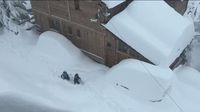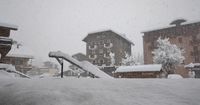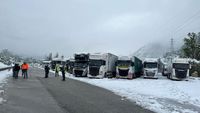Exceptional snowfall in the French Alps has led to significant disruptions and a heightened avalanche risk in the Savoie region. On Thursday, April 17, 2025, the department experienced extraordinary weather conditions, with nearly 1.40 meters of snow accumulating in just 18 hours, as reported by Olivier Duch, director of ski shops in Tignes. This prompted Météo France to issue an orange alert for avalanches, effective from 10:00 AM to 4:00 PM on Friday, April 18.
The avalanche activity, while expected to be reduced compared to Thursday, still poses a serious threat, particularly in areas like Haute-Maurienne, Haute-Tarentaise, and Vanoise. Météo France warned that large avalanches remain possible throughout the day, urging residents and visitors to exercise extreme caution.
As a result of the heavy snowfall, the Savoie region faced multiple challenges. Up to 5,000 homes were left without electricity on April 17 due to fallen trees damaging power lines. The outages primarily affected the Bourg-Saint-Maurice, Les Allues, and Saint-Martin-de-Belleville areas. By the evening of the same day, the number of affected homes had decreased to around 3,000, as technicians from Enedis worked tirelessly to restore power.
In addition to the power outages, the snow led to the closure of schools in Haute-Tarentaise and Haute-Maurienne, with municipal authorities issuing temporary confinement orders in Tignes, Val Thorens, and Les Ménuires. Transportation was severely impacted, with the TER line between Chambéry and Modane being interrupted until early afternoon on April 17. The situation on the roads was equally dire, as traffic jams formed around the Mont-Blanc and Fréjus tunnels, which were closed to trucks for much of the day.
Truck drivers experienced significant delays, with nearly 530 trucks blocked on the A43 highway due to the snow. Laurent, a truck driver from Brittany, expressed his frustration after being stuck for over seven hours, stating, "I'm blocked since 6 AM, and we are treated like dogs." Another driver, Joaquim, echoed his sentiments, sharing that he had been stuck for more than eight hours and questioned the lack of preparedness for the expected snowfall.
The heavy snowfall also posed a safety risk, as many vehicles were not equipped with snow tires, leading to blockages on the roads. The Société française du tunnel routier du Fréjus (SFTRF) reported that snow removal efforts began on Wednesday evening, with additional personnel called in to assist with the challenging conditions.
In the midst of the chaos, the avalanche alert reached a critical level of five out of five in several Savoyard resorts. Tragically, two individuals were buried by avalanches, one of whom was in critical condition and required immediate medical attention after being rescued at the entrance to Val Thorens. Benjamin Blanc, director of the ski area in the Vallée des Belleville, noted that the road was closed when the avalanche struck.
Despite the dire circumstances, there was a glimmer of hope as the weather forecast for Friday, April 18, indicated a potential return to clearer skies. However, the risk of further snow slides remains high, and authorities continue to urge caution.
As the region grapples with the aftermath of this unprecedented weather event, local officials are emphasizing the importance of vigilance and preparedness. The prefecture of Savoie has called for residents to be cautious during mountain activities, particularly with the ongoing avalanche risk.
In summary, the recent snowfall in Savoie has led to widespread disruptions, power outages, and significant safety concerns. With the avalanche alert still in effect, the region remains on high alert as residents and visitors navigate these challenging conditions. The situation serves as a stark reminder of the power of nature and the need for preparedness in the face of extreme weather.








